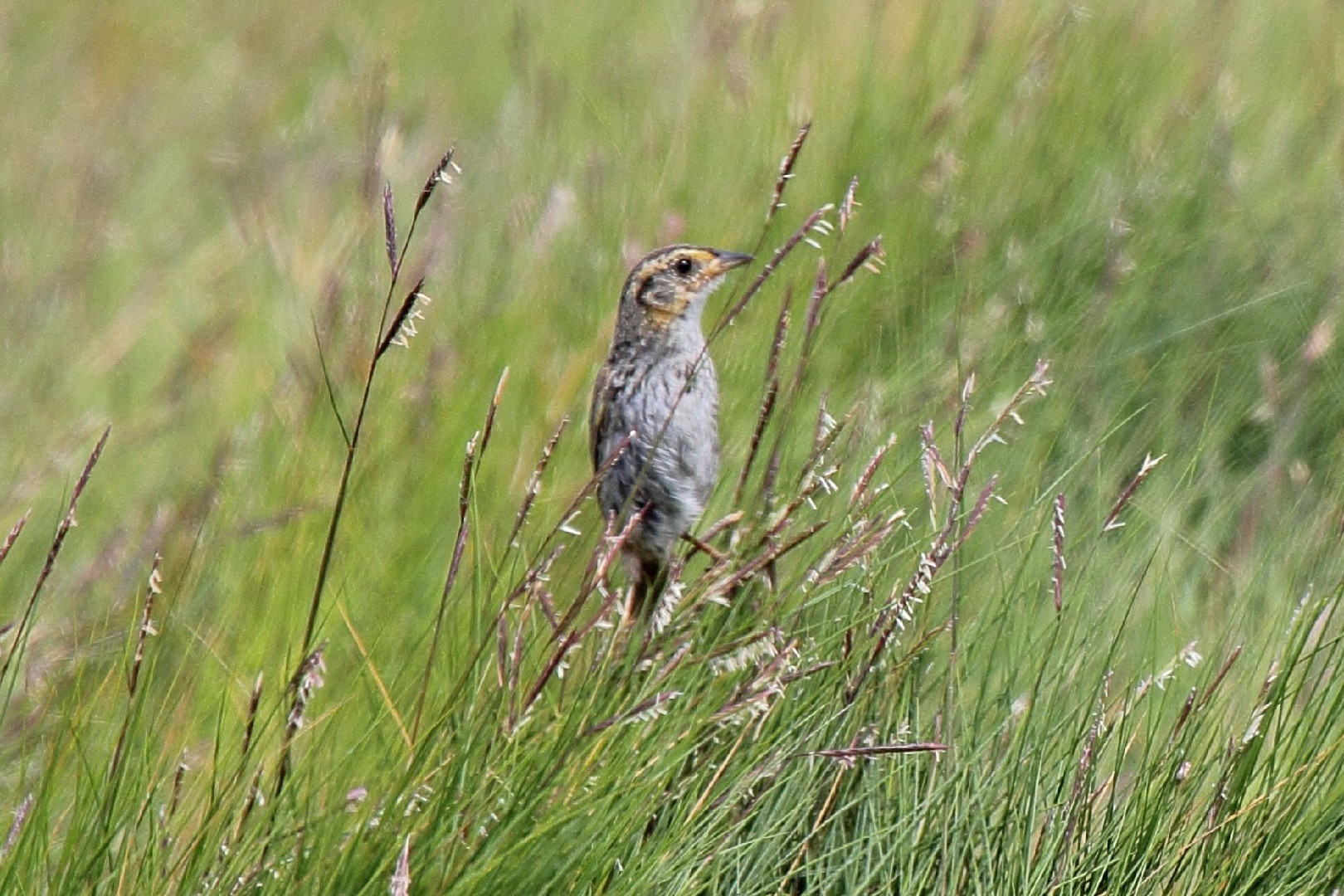Saltmarsh Sparrow
A species of Grassland sparrows Scientific name : Ammospiza caudacuta Genus : Grassland sparrows
Saltmarsh Sparrow, A species of Grassland sparrows
Botanical name: Ammospiza caudacuta
Genus: Grassland sparrows
Content
Description General Info
 Photo By Dominic Sherony , used under CC-BY-SA-2.0 /Cropped and compressed from original
Photo By Dominic Sherony , used under CC-BY-SA-2.0 /Cropped and compressed from original Description
The saltmarsh sparrow measures 11–14 cm (4.3–5.5 in) in length, has a wingspan of 17.8–21 cm (7.0–8.3 in), and weighs 14–23.1 g (0.49–0.81 oz). Adults have brownish upperparts with a gray nape, white throat and belly, and pale orange breast and sides with brown streaking. The face is orange with gray cheeks, a gray median crown stripe, brown lateral crown stripes, and a brown eyeline. The tail feathers are short and sharply pointed. Distinguishing this species from closely related sparrows such as the Nelson's sparrow can be difficult. The inland subspecies of the Nelson's sparrow can be differentiated by its fainter streaking and brighter orange breast and sides, while the coastal subspecies of the Nelson's sparrow can be differentiated by its paler, less-contrasting plumage. The saltmarsh sparrow also has a slightly longer beak than the Nelson's sparrow. 
Size
13 cm
Life Expectancy
7.9-10 years
Nest Placement
Ground
Clutch Size
3 - 6 eggs
Incubation Period
1 - 2 broods
Number of Broods
11 - 12 days
Nestling Period
9 - 10 days
Feeding Habits
Saltmarsh Sparrow consume a diet rich in insects, spiders, amphipods, and occasionally small fish and mollusks, with a prevalence of marsh plant seeds post-breeding. Insects like flies, moths, grasshoppers, and beetles are typical food, especially those endemic to saltmarshes. Saltmarsh Sparrow forage mainly ground-level, but ascend marsh vegetation as needed.
Habitat
Saltmarsh Sparrow primarily dwells in tidal saltmarshes, especially within high marsh zones with vegetation like saltmeadow cordgrass. Their nests are found in the supratidal areas that are more arid and remain above the high-tide mark. Saltmarsh Sparrow resides in these habitats throughout the year, and during migration periods, they are known to inhabit Atlantic coastal marshes.
Nest Behavior
The sole female saltmarsh Sparrow selects the site, builds the nest, and cares for the young without male help. She approaches the nest via tunnels in the grass thatch. Nest building aligns with higher marsh availability to mitigate flooding risks.
Nest Characteristics
Saltmarsh Sparrow builds a simple, bulky cup-shaped nest, typically less than 3 feet off the ground. It's constructed of marsh grasses and reeds, supported by stems and occasionally on a thatch of saltmeadow cordgrass to avoid high tide inundation. Some nests feature a partial dome.
Dite type
Insectivorous
General Info
Feeding Habits
Bird food type
Behavior
Saltmarsh Sparrow spend significant time engaging in foraging activities, particularly during periods of falling and low tides when marsh areas become accessible. Their primary diet comprises insects and arthropods found on the ground, which they skillfully hunt even under the moonlight. Adaptable to the marsh's harsh conditions, saltmarsh Sparrow can rapidly accumulate fat reserves to endure high tides and storm surges, indicating their resilience. During the breeding season in spring, male saltmarsh Sparrow roam expansively through marsh territories to locate females. Their mating behavior is subtle; males only vocalize their understated song upon encountering potential mates. Females openly signal their readiness to mate, while males may pursue and mate with less receptive females, exhibiting a unique aspect of their breeding strategy.
Distribution Area
The saltmarsh sparrow is only found in tidal salt marshes along the Atlantic coast of the United States. It breeds along the northern coast, from Maine to the Chesapeake Bay, and winters along the southern coast, from North Carolina to Florida. The saltmarsh sparrow prefers high marsh habitat, dominated by saltmeadow cordgrass (Spartina patens) and saltmarsh rush (Juncus gerardii), which does not flood as frequently as low marsh. 
Species Status
The saltmarsh sparrow is of high conservation concern due to habitat loss resulting in small fragmented populations. Salt marshes are one of the most threatened habitats worldwide due to their limited natural extent, long history of human modification, and anticipated sea level rise. The spread of the invasive reed Phragmites has also contributed to habitat loss. The saltmarsh sparrow is very sensitive to sea level rise because of the role of flooding in nest mortality. In addition, the saltmarsh sparrow is particularly susceptible to mercury bioaccumulation, but the effects of this on survival are unclear. Saltmarsh sparrow populations declined between 5% and 9% per year between the 1990s and 2010s, resulting in a total decline of over 75%. Without management intervention, the saltmarsh sparrow is projected to become extinct by 2050. The saltmarsh sparrow was listed on the 2016 State of North America's Birds Watch List with a concern score of 19 out of 20, and the U.S. Fish and Wildlife Service is currently undertaking a status review to determine whether the species should be listed under the Endangered Species Act. Its total population was estimated to be 53,000 in 2016. 
Scientific Classification
Phylum
Chordates Class
Birds Order
Perching birds Family
New world sparrows Genus
Grassland sparrows Species
Saltmarsh Sparrow